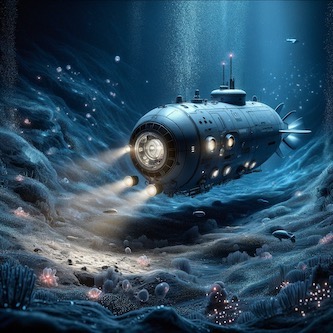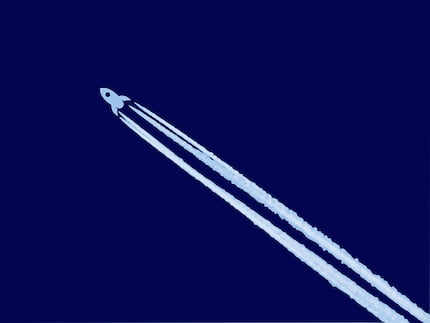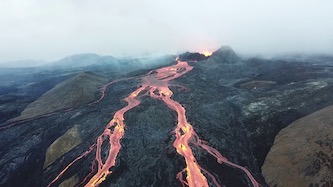Captain Don Walsh, an ocean explorer, has passed away at the age of 92. Over 60 years ago, he made history by descending to the deepest point in the ocean, the Mariana Trench, which is nearly 11 kilometers (seven miles) deep. At the time, space exploration was capturing the world’s attention, but Walsh had his sights set on exploring the depths of the ocean. He volunteered to join a mission with the US Navy, diving deeper than any human had gone before.
Walsh’s first reaction to the mission was surprise, as he had only been 100 meters deep in a submarine before. However, he believed that the submersible, called the bathyscaphe Trieste, could handle the immense pressure of the Mariana Trench. On January 23, 1960, Walsh and Swiss oceanographer Jacques Piccard began their descent. Inside the small submersible, they experienced extreme cold and increasing pressure as they descended into the darkness.
After hours of descent, they finally reached the bottom of the Mariana Trench. However, due to the sediment stirred up by their landing, they were unable to capture a photograph of the deepest place in the ocean. Despite this, Walsh and Piccard made history and received recognition for their achievement. Walsh went on to advocate for ocean exploration and safety within the industry.
In 2012, filmmaker James Cameron repeated the dive, and Walsh was there to congratulate him. In 2019, Walsh’s son, Kelly Walsh, also made the dive, going 8 meters deeper than his father. Walsh’s focus on the ocean, once considered the “wrong direction” compared to space exploration, is now recognized as crucial. Recent technological advancements have revealed the importance of the deep sea in understanding Earth’s systems, including its role in the carbon cycle and climate change. Walsh’s dive paved the way for further research and exploration of the ocean’s depths.
Original news source: Don Walsh: The man who made the deepest ever dive (BBC)
Listen
Slow
Normal
Fast
Group or Classroom Activities
Warm-up Activities:
– News Reporter Role-play
Instructions: Students pair up and one plays the role of a reporter while the other is Captain Don Walsh. The ‘reporter’ interviews ‘Walsh’ about his historic descent into the Mariana Trench, his feelings about the mission, and the importance of ocean exploration. Encourage students to use past tenses for the historical event and future tenses for discussing the implications of ocean exploration.
– Opinion Poll
Instructions: Pose a question to the class such as “Do you believe deep-sea exploration is as important as space exploration?” Have students move to different areas of the room based on their opinion (strongly agree, agree, neutral, disagree, strongly disagree). Allow students to discuss their reasons with peers and then share with the class, using persuasive language and referencing the article.
– Article Timeline
Instructions: On the board, draw a simple timeline starting from the historic dive in 1960 to the recent achievements and technological advancements in ocean exploration. Ask students to fill in the timeline with key events mentioned in the article, using the correct tenses and dates. They can work in small groups and present their timelines to the class afterward.
– Vocabulary Pictionary
Instructions: Write down key vocabulary from the article on slips of paper (e.g., ‘submersible’, ‘Mariana Trench’, ‘sediment’, ‘carbon cycle’). Students take turns drawing a slip and illustrating the word on the board without speaking or writing any letters. The rest of the class tries to guess the word. This activity focuses on reinforcing new vocabulary while engaging students in a fun and interactive way.
– Future Predictions
Instructions: Ask students to imagine the future of ocean exploration based on the progress and technological advancements mentioned in the article. Each student writes down one or two predictions for the next 50 years. Then, they share their predictions with a partner, discussing the potential outcomes and challenges of such explorations. Encourage them to use future tense constructions and modals for speculation (e.g., “might”, “could”, “will likely”).
Comprehension Questions:
1. At what age did Captain Don Walsh pass away?
2. How many years ago did Walsh make history by descending to the deepest point in the ocean?
3. What was the name of the submersible used by Walsh and Jacques Piccard to descend into the Mariana Trench?
4. On what date did Walsh and Piccard begin their historic descent?
5. Why were Walsh and Piccard unable to capture a photograph of the deepest place in the ocean?
6. Who repeated the dive to the bottom of the Mariana Trench in 2012?
7. How much deeper did Kelly Walsh, Don Walsh’s son, dive compared to his father?
8. What has recent technological advancements revealed about the importance of the deep sea?
Go to answers ⇩
Listen and Fill in the Gaps:
Captain Don Walsh, an ocean explorer, has passed away at the age of 92. Over 60 years ago, he made (1)______ by descending to the deepest (2)______ in the ocean, the (3)______ Trench, which is nearly 11 kilometers (seven miles) deep. At the time, space exploration was capturing the world’s attention, but Walsh had his sights set on exploring the depths of the ocean. He volunteered to join a (4)______ with the US Navy, diving deeper than any human had gone before.
Walsh’s first reaction to the mission was (5)______, as he had only been 100 meters deep in a (6)______ before. However, he (7)______ that the submersible, called the bathyscaphe Trieste, could handle the immense (8)______ of the Mariana Trench. On January 23, 1960, Walsh and Swiss oceanographer Jacques Piccard began their descent. Inside the small submersible, they experienced extreme cold and increasing pressure as they descended into the darkness.
After hours of descent, they finally (9)______ the bottom of the Mariana Trench. However, due to the sediment (10)______ up by their landing, they were unable to capture a photograph of the deepest place in the (11)______. Despite this, Walsh and Piccard made history and received recognition for their achievement. Walsh went on to advocate for ocean exploration and safety within the industry.
In 2012, (12)______ James Cameron repeated the dive, and Walsh was there to congratulate him. In 2019, Walsh’s son, Kelly Walsh, also made the dive, going 8 meters deeper than his father. Walsh’s focus on the ocean, once considered the “wrong direction” compared to (13)______ exploration, is now recognized as crucial. Recent (14)______ advancements have revealed the importance of the deep sea in understanding Earth’s systems, including its role in the carbon (15)______ and climate change. Walsh’s dive (16)______ the way for further research and exploration of the ocean’s depths.
Go to answers ⇩
Discussion Questions:
Students can ask a partner these questions, or discuss them as a group.
1. What is your opinion on the importance of ocean exploration compared to space exploration? Why?
2. How would you feel if you had the opportunity to explore an unknown part of our planet, like the deep sea or outer space?
3. Do you think there is enough recognition given to explorers of the Earth’s oceans? Why or why not?
4. What do you imagine are the biggest challenges faced by deep-sea explorers like Captain Don Walsh?
5. How do you think technological advancements have changed the way we explore and understand the ocean’s depths since Walsh’s historic dive?
6. Do you believe that exploring the deepest parts of the ocean is a valuable endeavor? Why or why not?
7. What is your perception of the risks involved in deep-sea exploration, and would you personally take those risks?
8. How do you feel about the fact that the deepest point in the ocean was reached over 60 years ago, yet much of the ocean remains unexplored?
9. Do you think the excitement and attention around space exploration overshadow the achievements made in ocean exploration?
10. How would you compare the legacies of ocean explorers like Don Walsh to that of astronauts?
11. Do you like the idea of following in a parent’s footsteps to achieve a similar feat, as Kelly Walsh did by diving deeper than his father? Why or why not?
12. What is your opinion on the role of the deep sea in understanding Earth’s climate and environmental systems?
13. How do you think the experience of being in a small submersible, like the Trieste, under extreme pressure and cold, would affect a person?
14. Do you think that the advancements in deep-sea exploration technology could lead to new industries or resources being developed from the ocean floor?
15. How do you think Captain Don Walsh’s view of the ocean as a frontier for exploration influenced future generations of scientists and explorers?
Individual Activities
Vocabulary Meanings:
Match each word to its meaning.
Words:
1. ocean
2. explorer
3. Mariana Trench
4. submarine
5. pressure
6. descent
7. history
8. dive
Meanings:
(a) The act of plunging into water, especially headfirst
(b) The vast body of saltwater covering the Earth’s surface
(c) The deepest point in the ocean, nearly 11 kilometers deep
(d) The study of past events and human achievements
(e) The force exerted by a fluid on a surface
(f) A person who travels to unfamiliar places for discovery
(g) The act of moving downward or lowering oneself
(h) A watercraft capable of operating underwater
Go to answers ⇩
Multiple Choice Questions:
1. Who was Captain Don Walsh?
(a) An ocean explorer
(b) An astronaut
(c) A filmmaker
(d) A scientist
2. Where did Captain Don Walsh make history by descending?
(a) Mount Everest
(b) The Mariana Trench
(c) The Great Barrier Reef
(d) The Amazon Rainforest
3. How deep is the Mariana Trench?
(a) 100 meters
(b) 1 kilometer
(c) Nearly 11 kilometers (seven miles)
(d) 50 meters
4. What was the name of the submersible used by Walsh and Piccard?
(a) The Mariana Explorer
(b) The bathyscaphe Trieste
(c) The Ocean Voyager
(d) The Deep Sea Challenger
5. What prevented Walsh and Piccard from capturing a photograph of the deepest place in the ocean?
(a) Technical difficulties with the camera
(b) Lack of proper lighting
(c) Extreme cold temperatures
(d) Sediment stirred up by their landing
6. Who repeated the dive to the Mariana Trench in 2012?
(a) Kelly Walsh
(b) Jacques Piccard
(c) Don Walsh
(d) James Cameron
7. What is now recognized as crucial in understanding Earth’s systems?
(a) The deep sea
(b) Space exploration
(c) Mountaintops
(d) The atmosphere
8. What did Walsh’s dive pave the way for?
(a) Space exploration missions
(b) Mountaineering expeditions
(c) Further research and exploration of the ocean’s depths
(d) Climate change studies
Go to answers ⇩
True or False Questions:
1. Walsh made history by descending to the deepest point in the ocean, the Mariana Trench.
2. Captain Don Walsh, an ocean explorer, has passed away at the age of 92.
3. Filmmaker James Cameron repeated the surf in 2012, and Walsh was not there to congratulate him.
4. Walsh joined a mission with the US Navy to dive deeper than any human had gone before.
5. Walsh and French oceanographer Jacques Piccard made their ascent in the bathyscaphe Trieste.
6. They were able to capture a photograph of the shallowest place in the ocean due to sediment stirred up by their landing.
7. Walsh’s focus on ocean exploration is now recognized as crucial for understanding Earth’s systems.
8. The Mariana Trench is nearly 11 meters (seven feet) deep.
Go to answers ⇩
Write a Summary:
Write a summary of this news article in two sentences.
Check your writing now with the best free AI for English writing!
Writing Questions:
Answer the following questions. Write as much as you can for each answer.
Check your answers with our free English writing assistant!
1. What historic achievement did Captain Don Walsh accomplish over 60 years ago?
2. How did Walsh’s prior experience compare to the depth he reached in the Mariana Trench?
3. What challenges did Walsh and Piccard face during their descent to the bottom of the Mariana Trench?
4. Who repeated Walsh’s historic dive in 2012, and what was Walsh’s reaction to this event?
5. How has the perception of ocean exploration changed since Walsh’s dive, and what role does the deep sea play in our understanding of Earth’s systems?
Answers
Comprehension Question Answers:
1. At what age did Captain Don Walsh pass away?
Captain Don Walsh passed away at the age of 92.
2. How many years ago did Walsh make history by descending to the deepest point in the ocean?
Walsh made history over 60 years ago by descending to the deepest point in the ocean.
3. What was the name of the submersible used by Walsh and Jacques Piccard to descend into the Mariana Trench?
The name of the submersible used by Walsh and Jacques Piccard was the bathyscaphe Trieste.
4. On what date did Walsh and Piccard begin their historic descent?
Walsh and Piccard began their historic descent on January 23, 1960.
5. Why were Walsh and Piccard unable to capture a photograph of the deepest place in the ocean?
Walsh and Piccard were unable to capture a photograph of the deepest place in the ocean because the sediment stirred up by their landing obscured their view.
6. Who repeated the dive to the bottom of the Mariana Trench in 2012?
Filmmaker James Cameron repeated the dive to the bottom of the Mariana Trench in 2012.
7. How much deeper did Kelly Walsh, Don Walsh’s son, dive compared to his father?
Kelly Walsh, Don Walsh’s son, dove 8 meters deeper than his father.
8. What has recent technological advancements revealed about the importance of the deep sea?
Recent technological advancements have revealed the importance of the deep sea in understanding Earth’s systems, including its role in the carbon cycle and climate change.
Go back to questions ⇧
Listen and Fill in the Gaps Answers:
(1) history
(2) point
(3) Mariana
(4) mission
(5) surprise
(6) submarine
(7) believed
(8) pressure
(9) reached
(10) stirred
(11) ocean
(12) filmmaker
(13) space
(14) technological
(15) cycle
(16) paved
Go back to questions ⇧
Vocabulary Meanings Answers:
1. ocean
Answer: (b) The vast body of saltwater covering the Earth’s surface
2. explorer
Answer: (f) A person who travels to unfamiliar places for discovery
3. Mariana Trench
Answer: (c) The deepest point in the ocean, nearly 11 kilometers deep
4. submarine
Answer: (h) A watercraft capable of operating underwater
5. pressure
Answer: (e) The force exerted by a fluid on a surface
6. descent
Answer: (g) The act of moving downward or lowering oneself
7. history
Answer: (d) The study of past events and human achievements
8. dive
Answer: (a) The act of plunging into water, especially headfirst
Go back to questions ⇧
Multiple Choice Answers:
1. Who was Captain Don Walsh?
Answer: (a) An ocean explorer
2. Where did Captain Don Walsh make history by descending?
Answer: (b) The Mariana Trench
3. How deep is the Mariana Trench?
Answer: (c) Nearly 11 kilometers (seven miles)
4. What was the name of the submersible used by Walsh and Piccard?
Answer: (b) The bathyscaphe Trieste
5. What prevented Walsh and Piccard from capturing a photograph of the deepest place in the ocean?
Answer: (d) Sediment stirred up by their landing
6. Who repeated the dive to the Mariana Trench in 2012?
Answer: (d) James Cameron
7. What is now recognized as crucial in understanding Earth’s systems?
Answer: (a) The deep sea
8. What did Walsh’s dive pave the way for?
Answer: (c) Further research and exploration of the ocean’s depths
Go back to questions ⇧
True or False Answers:
1. Walsh made history by descending to the deepest point in the ocean, the Mariana Trench. (Answer: True)
2. Captain Don Walsh, an ocean explorer, has passed away at the age of 92. (Answer: True)
3. Filmmaker James Cameron repeated the surf in 2012, and Walsh was not there to congratulate him. (Answer: False)
4. Walsh joined a mission with the US Navy to dive deeper than any human had gone before. (Answer: True)
5. Walsh and French oceanographer Jacques Piccard made their ascent in the bathyscaphe Trieste. (Answer: False)
6. They were able to capture a photograph of the shallowest place in the ocean due to sediment stirred up by their landing. (Answer: False)
7. Walsh’s focus on ocean exploration is now recognized as crucial for understanding Earth’s systems. (Answer: True)
8. The Mariana Trench is nearly 11 meters (seven feet) deep. (Answer: False)
Go back to questions ⇧













